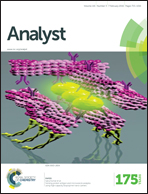Supersensitive and selective detection of picric acid explosive by fluorescent Ag nanoclusters†
Abstract
Picric acid (PA) explosive is a hazard to public safety and health, so the sensitive and selective detection of PA is very important. In the present work, polyethyleneimine stabilized Ag nanoclusters were successfully used for the sensitive and selective quantification of PA on the basis of fluorescence quenching. The quenching efficiency of Ag nanoclusters is proportional to the concentration of PA and the logarithm of PA concentration over two different concentration ranges (1.0 nM–1 μM for the former and 0.25–20 μM for the latter), thus the proposed quantitative strategy for PA provides a wide linear range of 1.0 nM–20 μM. The detection limit based on 3σ/K is 0.1 nM. The quenching mechanism of Ag nanoclusters by PA is discussed in detail. The results indicate that the selective detection of PA over other nitroaromatics including 2,4,6-trinitrotoluene (TNT), 2,4-dinitrotoluene (2,4-DNT), p-nitrotoluene (p-NT), m-dinitrobenzene (m-DNB), and nitrobenzene (NB), is due to the electron transfer and energy transfer between PA and polyethyleneimine-capped Ag nanoclusters. In addition, the experimental data obtained for the analysis of artificial samples show that the proposed PA sensor is potentially applicable in the determination of trace PA explosive in real samples.


 Please wait while we load your content...
Please wait while we load your content...